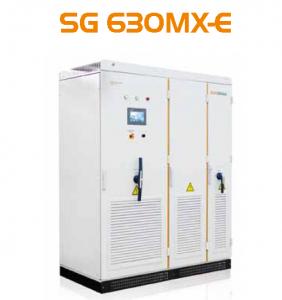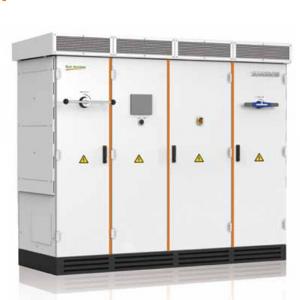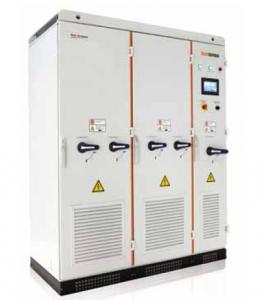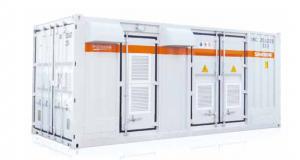Photovoltaic Grid-Connected Inverter SG630MX-E Solar Inverter
- Loading Port:
- China Main Port
- Payment Terms:
- TT or LC
- Min Order Qty:
- 10 unit
- Supply Capability:
- 1000 unit/month
OKorder Service Pledge
OKorder Financial Service
You Might Also Like
1. Structure of Photovoltaic Grid-Connected Inverter SG630MX-E Description
A solar inverter, or PV inverter, or Solar converter, converts the variable direct current (DC) output of a photovoltaic (PV) solar panel into
autility frequency alternating current (AC) that can be fed into a commercial electrical grid or used by a local, off-grid electrical network.
It is acritical BOS–component in a photovoltaic system, allowing the use of ordinary AC-powered equipment.
Solar inverters have special functions adapted for use with photovoltaic arrays, including maximum power point tracking and anti-islanding protection.
Suitable for 50Hz/60Hz grid, could be used in Asia, Australia and Europe.
2. Main Features of the Photovoltaic Grid-Connected Inverter SG630MX-E
• LVRT (Zero-voltage Ride-through)
• Active power continuously adjustable (0~100%)
• Reactive power control with power factor from 0.9 lagging to 0.9 leading
• DC input voltage up to 1000V
• Latest 32 bit DSP chip, advanced digital lock-in technique, more quickly and precisely
• -30℃~+55℃ continuously operating at rated power
• Continuously and stably working in high altitude environment
• Auxiliary heater (Optional)
3. Photovoltaic Grid-Connected Inverter SG630MX-E Images
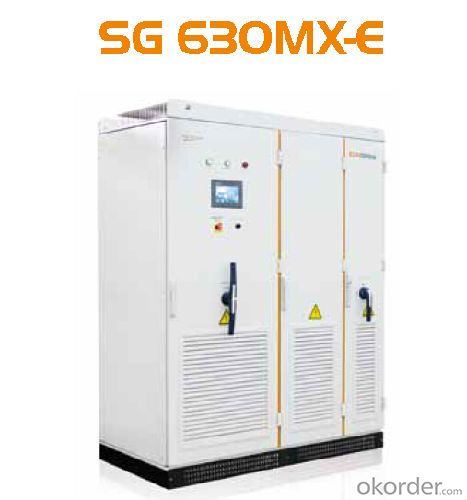
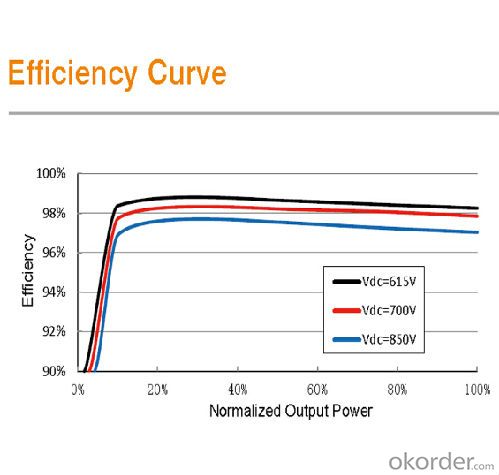
4. Photovoltaic Grid-Connected Inverter SG630MX-E Specification
Input Side Data | |
Max. PV input power | 713KW |
Max. PV input voltage | 1000V |
Startup voltage | 635V |
Min. operation voltage | 615V |
Max. PV input current | 1160A |
MPP voltage range | 615~850V |
No. of DC inputs | 8 |
Output Side Data | |
Nominal AC output power | 630kVA |
Max. AC output apparent power | 700KVA |
Max. AC output current | 1010A |
THD | < 3 % (Nominal power) |
Nominal AC voltage | 400V |
AC voltage range | 320V~460V |
Nominal grid frequency | 50/60Hz |
Grid frequency range | 47~52/57~62Hz |
Power factor | >0.99@default value at nominal power, (adj. 0.9 overexited ~0.9 underexited) |
Isolated transformer | No |
DC current injection | <0.5 %In |
Efficiency | |
Max. efficiency | 98.60% |
Max. European efficiency | 98.50% |
Protection | |
Input side disconnection device | DC load switch |
Output side disconnection device | AC load Switch |
DC overvoltage protection | Yes |
AC overvoltage protection | Yes |
Grid monitoring | Yes |
Ground fault monitoring | Yes |
Over temperature protection | Yes |
Insulation monitoring | Yes |
Surge arrester for auxiliary supply | Yes |
General Data | |
Dimensions(W×H×D) | 1606×2304×860mm |
Weight | 1700kg |
Operating ambient temperature range | -30~65℃(>55℃ derating) |
Night power consumption | <100W |
External auxiliary supply voltage | 400V |
Cooling method | Temperature controlled air-cooling |
Ingress protection rating | IP21 |
Allowable relative humidity range | 0~95% no condensing |
Max. operating altitude | 6000m (>3000m derating) |
Fresh air consumption | 4500 m3/h |
Display | Colored touch screen |
Communication | RS485/Modbus, Ethernet(Opt.) |
5. FAQ of Photovoltaic Grid-Connected Inverter SG630MX-E
Q1. What is the difference between inverter and solar inverter?
A1. Inverter only has AC inpput, but solar inverter both connect to AC input and solar panel, it saves more power
Q2. What is the difference between MPPT&PWM?
A2. MPPT has higher efficiency, it can track the max power point and won't waste energy.
- Q:How does a solar inverter handle voltage drops in the electrical wiring?
- A solar inverter handles voltage drops in the electrical wiring by continuously monitoring the voltage and adjusting its output accordingly. It boosts the voltage if it detects a drop, ensuring that the desired voltage levels are maintained for efficient power transmission and utilization.
- Q:Can a solar inverter be used for commercial applications?
- Yes, a solar inverter can be used for commercial applications. Solar inverters are an essential component of commercial solar power systems, as they convert the direct current (DC) electricity generated by solar panels into alternating current (AC) electricity that can be used to power commercial buildings and equipment.
- Q:What is the maximum output voltage of a solar inverter?
- The maximum output voltage of a solar inverter depends on its design and specifications. Generally, the maximum output voltage can range from 240 to 600 volts for residential inverters, and up to several thousand volts for commercial or utility-scale inverters.
- Q:What are the safety certifications to look for in a solar inverter?
- Some safety certifications to look for in a solar inverter include UL 1741, IEC 62109, and CSA C22.2 No. 107.1. These certifications ensure that the inverter meets specific safety standards, such as protection against electrical shocks, fire hazards, and grid disturbances. It is essential to check for these certifications to ensure the safe and reliable operation of the solar inverter.
- Q:What is the maximum power capacity that a solar inverter can handle?
- The maximum power capacity that a solar inverter can handle varies depending on the specific model and brand. However, modern solar inverters can typically handle power capacities ranging from a few hundred watts to several megawatts.
- Q:How long do solar inverters typically last?
- Solar inverters typically last for around 10 to 15 years, although some high-quality inverters can last up to 20 years with proper maintenance and regular inspections.
- Q:Can a solar inverter be used in areas with high levels of dust or pollution?
- Yes, a solar inverter can be used in areas with high levels of dust or pollution. However, it is important to regularly clean and maintain the inverter to ensure its optimal performance. Dust and pollution can potentially accumulate on the inverter's surface, affecting its efficiency and lifespan. Regular cleaning and maintenance will help mitigate any issues and ensure the inverter continues to function effectively.
- Q:How do I choose the right solar inverter for my system?
- When choosing the right solar inverter for your system, there are several factors to consider. Firstly, you need to assess the size and capacity of your solar panel system to ensure that the inverter can handle the expected power generation. Additionally, consider the type of inverter, such as string inverters, microinverters, or power optimizers, based on the specific needs and limitations of your system. It's also essential to check the inverter's efficiency, warranty, and reliability, as well as compatibility with other system components like batteries or monitoring systems. Lastly, consider your budget and choose an inverter that offers a balance between quality and cost-effectiveness. Consulting with a professional solar installer can provide valuable insights and help you make an informed decision.
- Q:How does a solar inverter handle harmonics in the grid?
- A solar inverter handles harmonics in the grid by implementing various techniques such as filtering, synchronization, and control algorithms. These techniques help in mitigating harmonics and ensuring that the power generated from the solar panels is synchronized and compatible with the grid's electrical frequency and voltage. The inverter's control system monitors the grid's harmonics and adjusts its output accordingly to minimize any adverse effects and maintain grid stability.
- Q:What is the role of a solar inverter in preventing islanding?
- The role of a solar inverter in preventing islanding is to constantly monitor the electrical grid and immediately disconnect from it if it detects a fault or disruption. By disconnecting from the grid, the solar inverter ensures that it does not continue to generate power and create a self-sustaining island of electricity, which could pose a safety risk for utility workers attempting to fix the fault.
1. Manufacturer Overview |
|
|---|---|
| Location | |
| Year Established | |
| Annual Output Value | |
| Main Markets | |
| Company Certifications | |
2. Manufacturer Certificates |
|
|---|---|
| a) Certification Name | |
| Range | |
| Reference | |
| Validity Period | |
3. Manufacturer Capability |
|
|---|---|
| a)Trade Capacity | |
| Nearest Port | |
| Export Percentage | |
| No.of Employees in Trade Department | |
| Language Spoken: | |
| b)Factory Information | |
| Factory Size: | |
| No. of Production Lines | |
| Contract Manufacturing | |
| Product Price Range | |
Send your message to us
Photovoltaic Grid-Connected Inverter SG630MX-E Solar Inverter
- Loading Port:
- China Main Port
- Payment Terms:
- TT or LC
- Min Order Qty:
- 10 unit
- Supply Capability:
- 1000 unit/month
OKorder Service Pledge
OKorder Financial Service
Similar products
New products
Hot products
Hot Searches
Related keywords
